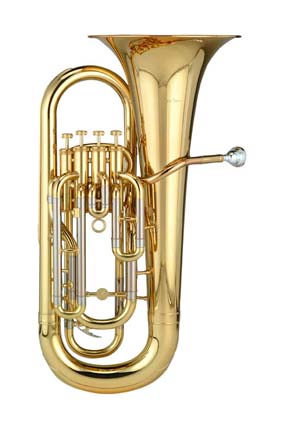euphonium
yoo-FOE-nee-um
[English]
HISTORY: The concertmaster Sommer of Weimar designed the euphonium in 1843, which was a wide-bored valved bugle in the baritone range. This instrument was then called the Euphonion. A brass instrument of the tuba family, smaller and higher in pitch than a tuba, with a range of B♭1 below the bass clef to B♭4 in the treble clef. This instrument is mostly used in concert bands and military bands. The euphonium has taken the place of Richard Wagner's tenor tuba. All of the music originally written for the tenor tuba is now typically performed on the euphonium.
PHYSICAL DESCRIPTION: The euphonium is constructed in the way that it looks like a miniature tuba. It contains a conical bore and a flared bell, with four valves.
SOUND PROPERTIES: Sound is produced with the euphonium by the performer vibrating his/her lips against the mouthpiece. A very mellow and smooth tone is produced from the instrument without the pitch problems that occurred and plagued the Wagner tubas, but the euphonium is only used to replace the tenor tuba.
RANGE: The euphonium’s range is the same as the bass trombone starting in the bass clef ranging from B♭1 below the bass clef to B♭4 above the bass clef. The euphonium is also a non-transposing instrument.
Example
 Photo courtesy of G. Leblanc Corporation
Photo courtesy of G. Leblanc Corporation

See Also
[French] basse à pistons[French] baryton
[Italian] eufonio
[Spanish] bombardino
Share
Tweet
Last Updated: 2016-05-24 14:20:55

